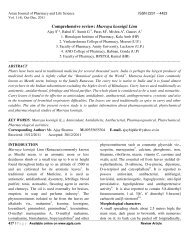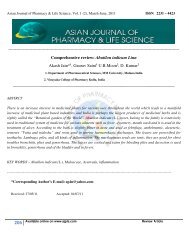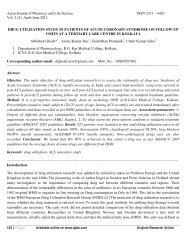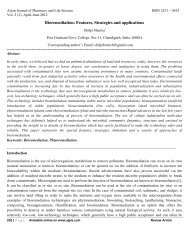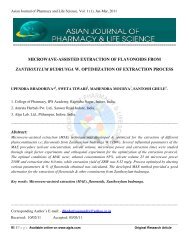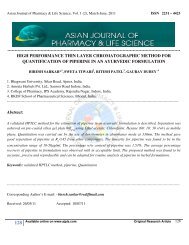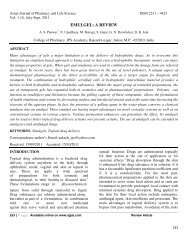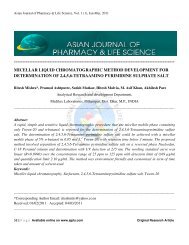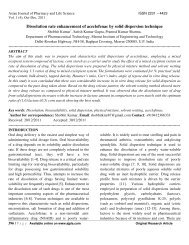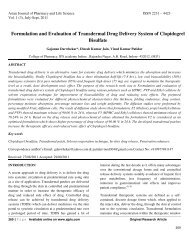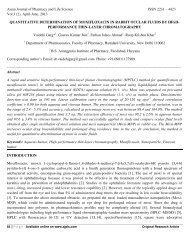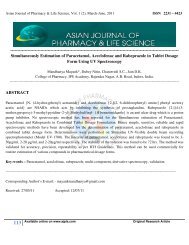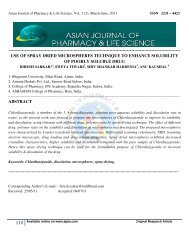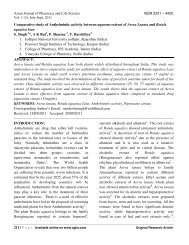Free radicals v/s Antioxidants - asian journal of pharmacy & life ...
Free radicals v/s Antioxidants - asian journal of pharmacy & life ...
Free radicals v/s Antioxidants - asian journal of pharmacy & life ...
Create successful ePaper yourself
Turn your PDF publications into a flip-book with our unique Google optimized e-Paper software.
Asian Journal <strong>of</strong> Pharmacy and <strong>life</strong> science, Vol. 1 (1), Jan-Mar, 2011<br />
==============================================================================<br />
<strong>Free</strong> <strong>radicals</strong> v/s <strong>Antioxidants</strong>: The deadly Demons v/s the friendly scavengers: A review<br />
Sanjeev Narang 1 *, Ashok Yadav 1 , Meenal Vaidya 2<br />
1. Department <strong>of</strong> Pathology, MGM Medical College, Indore (M.P.)<br />
2. Department <strong>of</strong> Biochemistry, MGM Medical College, Indore (M.P.)<br />
--------------------------------------------------------------------------------------------------------------------------------------<br />
Introduction<br />
Biological combustion produces harmful<br />
intermediates called free <strong>radicals</strong>. A free radical<br />
is simply defined as any species capable <strong>of</strong><br />
independent existence that contains one or more<br />
unpaired electron that is alone in an orbital.<br />
There are two major types <strong>of</strong> free <strong>radicals</strong><br />
Nitrogen Oxygen species (NOS) and Reactive<br />
Oxygen species (ROS) 1 . <strong>Free</strong> <strong>radicals</strong> are<br />
continuously produced by the body’s aerobic <strong>life</strong><br />
and our metabolism. <strong>Free</strong> <strong>radicals</strong> are also<br />
generated through environmental pollutants like<br />
cigarette smoke, radiation, air pollutants,<br />
pesticides etc. so these free <strong>radicals</strong> are an<br />
integral part <strong>of</strong> our daily <strong>life</strong> and in fact there<br />
appears no escape from them 2 . Nitric oxide acts<br />
on a variety <strong>of</strong> tissues normally but too much <strong>of</strong><br />
it can be toxic. It has bee associated with lots <strong>of</strong><br />
Corr. Author’s E-mail:sanjupath@rediffmail.com<br />
Received: 01/02/2011 Accepted: 03/03/2011<br />
diseases. Exposure to this free radical is highly<br />
toxic 3 .<br />
ROS are formed during the reduction <strong>of</strong> oxygen<br />
to water. About 98% <strong>of</strong> inspired oxygen is<br />
reduced to water during lipolysis, inflammatory<br />
processes, production <strong>of</strong> chemical energy and<br />
several other biological processes. Remaining<br />
2% <strong>of</strong> inspired oxygen leads to the formation <strong>of</strong><br />
major ROS i.e. super oxide ion (O²) Hydrogen<br />
peroxide (H²O²) and Hydroxyl ion (OH).<br />
Besides these, two minor classes Trichloro<br />
methyl (CCL³) a carbon centered radical thiyl<br />
(RS) a sulphur – centered radical etc. are also<br />
produced during different biochemical processes.<br />
All these free <strong>radicals</strong> are generated in the body<br />
and they become stable by “stealing” electrons<br />
from nucleic acids, lipids or any near by<br />
molecule by a process called reduction.<br />
95 | P a g e Available online on www.ajpls.com Review Article
Asian Journal <strong>of</strong> Pharmacy and <strong>life</strong> science, Vol. 1 (1), Jan-Mar, 2011<br />
The molecule that picks up an electron is reduced<br />
or stabilized and the molecule that loses an<br />
electron is oxidized. If this stealing <strong>of</strong> electron is<br />
left unchecked by the body’s defense system the<br />
creation <strong>of</strong> free radical launches a chain reaction<br />
that results in cellular damage and various<br />
diseases 1-5 .<br />
<strong>Free</strong> radical management by body’s defense<br />
system<br />
<strong>Antioxidants</strong> are the substances, which act<br />
against oxidative compounds. They have been<br />
defined as substances that are capable <strong>of</strong><br />
preventing oxidation <strong>of</strong> easily oxidizable<br />
materials 6 . <strong>Antioxidants</strong> may exert their effects<br />
by different mechanisms such as suppressing the<br />
formation <strong>of</strong> active species (ROS, NOS)<br />
scavenging active free <strong>radicals</strong>, repairing the<br />
damage and biosynthesis <strong>of</strong> other antioxidants or<br />
defense enzymes 7 .<br />
Under normal conditions the body’s antioxidants<br />
convert ROS to H2O2 to prevent the over<br />
production <strong>of</strong> free <strong>radicals</strong>. The four main<br />
antioxidants in the body are Catalase, Super<br />
oxide dismutase (SOD), Glutathione peroxidase<br />
and Glutathione reductase 8 . The body’s complex<br />
antioxidant enzyme system is influenced by two<br />
<strong>of</strong> the most familiar antioxidants i.e. vitamin E<br />
and C. Studies have shown that vitamin C and<br />
Vitamin E effectively scavenge free <strong>radicals</strong> and<br />
decrease lipid peroxidation 9 . Flavonoides are<br />
substances <strong>of</strong> vegetable origin also found to act<br />
as effective antioxidants.<br />
In our body when level <strong>of</strong> free <strong>radicals</strong> exceeds<br />
the capacity <strong>of</strong> antioxidants to detoxify them then<br />
it results in “oxidative stress”. This leads to<br />
several diseases, which regardless <strong>of</strong> their<br />
initiating pathological events share a series <strong>of</strong><br />
steps that lead to a common mechanistic pathway<br />
<strong>of</strong> oxidative stress through regulatory oxidative<br />
signals 10 .<br />
<strong>Free</strong> <strong>radicals</strong> play a major role in Aging<br />
Aging is the decline in physiologic functions <strong>of</strong><br />
the living organisms that occurs over time. For<br />
all organisms the ultimate culmination <strong>of</strong> aging is<br />
same i. e. Death. Several theories <strong>of</strong> aging have<br />
been propounded from time. Among them<br />
Harman proposed “The free radical theory <strong>of</strong><br />
aging” in Nov. 1954 11 . Human studies have also<br />
shown a strong connection between the radical/<br />
oxidative damage and aging.Oxidative damage to<br />
DNA is an ongoing process in our body and it<br />
tends to increase with age. Several age dependent<br />
markers have been documented for this, which<br />
provide evidence <strong>of</strong> oxidative damage to DNA in<br />
human aging 12 .<br />
<strong>Free</strong> <strong>radicals</strong> and disorders<br />
Atherosclerosis – Oxidative stress especially<br />
oxidation <strong>of</strong> low density lipoproteins (LDL) has<br />
long been suspected to play a critical role in<br />
atherogenesis that leads to accumulation <strong>of</strong><br />
cholesterol in the atherosclerotic lesion 13 . Many<br />
96 | P a g e Available online on www.ajpls.com Review<br />
Article
Asian Journal <strong>of</strong> Pharmacy and <strong>life</strong> science, Vol. 1 (1), Jan-Mar, 2011<br />
observations support the view that<br />
hyperlipidemia is merely a risk factor and<br />
oxidative stress is the root cause <strong>of</strong><br />
atherogenesis 14 . It was observed that high fat diet<br />
affects 32 genes; however only three genes were<br />
observed to be related to atherogenesis and some<br />
showing decreased expression were those <strong>of</strong> free<br />
radical scavenging enzymes resulting in<br />
increased oxidative stress. This experiment also<br />
showed that oxidative stress induces<br />
atherogenesis 15 .<br />
Alzheimer – Recent evidence in the field <strong>of</strong><br />
Alzheimer disease research has highlighted the<br />
importance <strong>of</strong> oxidative process in the<br />
pathogenesis 16 .Alzheimer disease is the<br />
commonest form <strong>of</strong> dementia in women and men<br />
aged 60-69 years 17 . However the initial source <strong>of</strong><br />
oxidative stress in Alzheimer disease is still<br />
unclear. Recent research reveals that dietary<br />
antioxidants may have promising therapeutic<br />
potential in delaying the onset as well as<br />
preventing the aging population with Alzheimer<br />
disease and its related complications 18 .<br />
Neurodegenerative Diseases- The role <strong>of</strong><br />
antioxidants has been studied in neurological<br />
disorders also. Patients <strong>of</strong> Amyotrophic lateral<br />
sclerosis (ALS) and Down’s syndrome show<br />
decreased level <strong>of</strong> SOD. After many studies it<br />
has been concluded that a deterioration <strong>of</strong> the<br />
antioxidant defense system contributes to<br />
neuronal death and we can consider free <strong>radicals</strong><br />
as the first cause <strong>of</strong> neurodegenerative<br />
disorders 19,20 .<br />
Cancer – The process <strong>of</strong> development <strong>of</strong> cancer<br />
can be divided in to three stages. The first stage<br />
is initiation, second is promotion and third is<br />
progression. <strong>Free</strong> <strong>radicals</strong> play the role <strong>of</strong><br />
mediators in carcinogensis especially in the stage<br />
<strong>of</strong> initiation and promotion. Each stage involves<br />
both genetic and epigenetic changes 21 . Sequence<br />
specificity <strong>of</strong> DNA damage plays a key role in<br />
the mutagenic process. Endogenous DNA<br />
damage arises from a verity <strong>of</strong> intermediates <strong>of</strong><br />
oxygen reduction and several free <strong>radicals</strong> are<br />
now known to take part in this process by various<br />
mechanisms. Apart from these actions,<br />
antioxidants have also been documented as<br />
anticancer agents 22 .<br />
Diabetes and diabetic complications-<br />
Considerable evidence supports the fact that<br />
hyperglycemia results in the generation <strong>of</strong> ROS.<br />
One major consequence <strong>of</strong> this is the expression<br />
<strong>of</strong> gene products that cause cellular damage and<br />
are ultimately responsible for late complications<br />
<strong>of</strong> diabetes 23 . The ability <strong>of</strong> antioxidants / free<br />
radical scavengers to protect from the effects <strong>of</strong><br />
hyperglycemia and free fatty acids along with<br />
clinical benefits following antioxidants therapy<br />
indirectly proves the role <strong>of</strong> oxidative stress in<br />
causing these abnormalities 24 .<br />
Stroke- It’s the leading cause <strong>of</strong> death and<br />
disability in the USA. In the general population<br />
97 | P a g e Available online on www.ajpls.com Review<br />
Article
Asian Journal <strong>of</strong> Pharmacy and <strong>life</strong> science, Vol. 1 (1), Jan-Mar, 2011<br />
incidence <strong>of</strong> stroke is 1/1000 individuals;<br />
however incidence doubles in individuals who<br />
are 80 years and above <strong>of</strong> age 25 . The newer<br />
developments also support views that agents that<br />
scavenge free <strong>radicals</strong> or prevent their production<br />
may be able to prolong the therapeutic time<br />
window. Several antioxidants and free radical<br />
scavenging based therapeutics have been recently<br />
launched and are under development for<br />
treatment purpose 26 .<br />
Having explored in various ways the universe <strong>of</strong><br />
free <strong>radicals</strong>, their formation, their role in our<br />
body, and their implication in disease we<br />
conclude that an increase in free <strong>radicals</strong> or<br />
reduction in antioxidant defense system leads to<br />
oxidative stress. This causes many complications<br />
which means to say that antioxidants can be used<br />
to treat oxidative stress generated disorders.<br />
However as always the dictum <strong>of</strong> “prevention is<br />
better than cure” should be followed and a<br />
complete diet should be the rule rather than an<br />
exception. Although supplementary antioxidants<br />
can be useful but should not be used as a<br />
replacement for a wholesome diet and other<br />
<strong>life</strong>style factors known to prevent diseases.<br />
Consumption <strong>of</strong> fresh fruits and vegetables,<br />
regular exercise and smoking cessation are all –<br />
important for reducing the risk <strong>of</strong> disease.<br />
Presented below is a summary <strong>of</strong> the salient<br />
features <strong>of</strong> the <strong>Free</strong> <strong>radicals</strong>, their effects and<br />
antioxidants in poetry form:<br />
H2O2, O2 and OH----Deadly all three,<br />
Commonly known they are as <strong>radicals</strong> free.<br />
Electrons they steal and become stable,<br />
Of causing oxidative stress, they are capable.<br />
<strong>Antioxidants</strong>---the friendly scavengers,<br />
Function they, as the body’s avengers.<br />
SOD and Catalase we have got,<br />
Glutathiones also forget we should not.<br />
Aging—the free <strong>radicals</strong> cause and induce,<br />
Creases and wrinkles in everyone they produce.<br />
Oxidative damage to DNA---a major event,<br />
Try as much one might, but cannot prevent.<br />
Atherogenesis—the killer deadly but mute.<br />
Oxidative stress is present at its root.<br />
Alzheimer—the curse <strong>of</strong> Mankind,<br />
Dig deep and free <strong>radicals</strong> you find.<br />
Causing damage neuronal is their creed,<br />
To Amyotrophic Lateral Sclerosis and down’s<br />
they lead.<br />
Initiation and Promotion in cancers seen,<br />
Attributed to free <strong>radicals</strong> it has been.<br />
Mutation around DNA damage revolves,<br />
98 | P a g e Available online on www.ajpls.com Review<br />
Article
Asian Journal <strong>of</strong> Pharmacy and <strong>life</strong> science, Vol. 1 (1), Jan-Mar, 2011<br />
Action by most free <strong>radicals</strong>, that involves.<br />
Diabetes and its complications known and<br />
unknown,<br />
To them, oxidative stress makes the patient<br />
prone.<br />
Stroke disability or death is the effect,<br />
If antioxidant mechanism has a defect.<br />
With antioxidants Mother Nature does abound,<br />
In most fresh fruits and vegetables found.<br />
Consume them aplenty and keep stress at bay,<br />
Lead a disease free and healthy <strong>life</strong> you may.<br />
References:<br />
1. Goodyear Bruch C. Pierce J.D. 2000:<br />
Oxidative stress in critically ill patients: Amj.<br />
Crit. Care 11 (6)543.<br />
2. Ashok K. Tiwatri. <strong>Antioxidants</strong> New<br />
generation therapeutic bases treatment <strong>of</strong><br />
polygenic disorder current science Vol. 86 no. 8<br />
page 1092.<br />
3. Patel R.P. meollering D. et al (2000) cell<br />
signaling by reactive nitrogen and oxygen<br />
species in Atherosclerosis free radical biomed<br />
med 28 (12) 1780.<br />
4. Kerr M.E. Bender C.M. and Monti E.J. (1996)<br />
An introduction to oxygen free <strong>radicals</strong> Heart<br />
lung 25 (3) 2000.<br />
5. Willson and Clancy R.L. (2001) Reactive<br />
oxygen species in acute respiratory disease<br />
syndrome Heart Lung 30 (5) 370.<br />
6. Chipault J. R antioxidants for use in food in<br />
auto – oxidation and antioxidants: Interscience<br />
New York 1962 Vol. II 477-542.<br />
7. Noguchi N. Watanabe A. and shi h. diverse<br />
functions <strong>of</strong> antioxidants free radical Res. (2000)<br />
33: 809-817.<br />
8. Halliwell B. (1994) free <strong>radicals</strong> antioxidants<br />
and human disease curiosity cause or<br />
consequence : Lancet 344-721.<br />
9. Kendler B.S. (1995) free radical in health and<br />
disease Implications for primary health care<br />
providers Nurse Pract. 20 (7) 29.<br />
10. Morganti M. etal Atherosclerosis and cancer:<br />
common pathway on vascular endothelium<br />
Biomed. Pharmacother (2002) 56 317 -324.<br />
11. Harman D. (1956) Aging A theory based on<br />
free radical and radiation chemistry J. Gerontall<br />
11: 298: 300.<br />
12. Mccocci P etal (1999) Age dependent<br />
increase on oxidative damage to DNA, lipids and<br />
protein human skeletal muscle. <strong>Free</strong> radical<br />
bio.26 303-308.<br />
13. Brown M.S. Glodstein J.L. Lipoprotein<br />
Metabolism in the macrophage: complication <strong>of</strong><br />
cholesterol deposition in Atherosclerosis. Annual<br />
Review biochem.1983: 52:223:261.<br />
14. Steinberg D. parthsarathy S. Crew. T.E.<br />
Khoo J.C. and Witztum J.L. Beyond cholesterol<br />
99 | P a g e Available online on www.ajpls.com Review<br />
Article
Asian Journal <strong>of</strong> Pharmacy and <strong>life</strong> science, Vol. 1 (1), Jan-Mar, 2011<br />
modification and LDL that increase<br />
ethrogenecity. N. England J. Med 1989:320:915-<br />
952.<br />
15. Sreekumar R. etal. Impact <strong>of</strong> high fat diet and<br />
antioxidant supplement on mitochomdrial<br />
function and gene transcripts in rat muscle. Amj.<br />
Physiology Endocrino. Meta 2002:33:1480-89.<br />
16. Roltkamp Catherine etal. Alzheimer disease<br />
and associated disorder. Supplement S 62-68<br />
(2000).<br />
17. Rocca W. A. etal. Frequency and distribution<br />
<strong>of</strong> Alzheimer disease in Europe: A collaborative<br />
study <strong>of</strong> 1980-1990 prevalence findings. Ann.<br />
Neurol (1991) 30: 381-390.<br />
18. Engethart M.J. Dietry intake <strong>of</strong> antioxidant<br />
and risk <strong>of</strong> Alzheimer disease JAM (2003)<br />
287:3223-3229.<br />
19. Halliwell, B. 2001. Role <strong>of</strong> free radical in the<br />
neurodegenerative diseases. Therapeutic<br />
implications for antioxidant treatment. Drugs and<br />
Aging 18 (9): 685-716.<br />
20. Hensley. K. N. hall R. Subramaniam P. Cole<br />
M. harris etal 1995 Brain regional<br />
correspondence between Alzheimer‘s disease<br />
histopathology and biomarkers <strong>of</strong> protein<br />
oxidation J. Neurochem. 65 : 2146-2156.<br />
21. Ibid. <strong>Free</strong> Radical Biol & med. 13: 341-390<br />
(1992).<br />
22. Canfield L.M. etal Proc. Soc. Exp. Biol &<br />
Med 200, 260ff (1992).<br />
23. Evans J. Goldfine I.D. Maddux B.A. and<br />
Grodsky G.M. Oxidative stress and stress<br />
activated signaling pathway: a unifying<br />
hypothesis <strong>of</strong> type -2 Endocr. Rev 23, 599-622.<br />
24. Fanh Y.Z. Yang S. and WU G. <strong>Free</strong> radical’s<br />
antioxidants and nutrition : Nutrition 2002, 18:<br />
872-879.<br />
25. Sorbrra L.A. Lesson P.A Maddux etal<br />
Oxidative stress and stress activated signaling<br />
pathway: a unifying hypothesis <strong>of</strong> type-2<br />
diabetes Endocr. Rev.2002, 23: 599-622.<br />
26. Butterfiled D.A.A. Castegna C.M.<br />
Lauderback and J Drake 2002. Evidence that<br />
amyloid beta –peptide – includes lipid<br />
peroxidation and its sequelae in Alzheimer’s<br />
diseases brain contribute to neuronal death.<br />
Neurobiol Aging 23 (5): 655-664.<br />
100 | P a g e Available online on www.ajpls.com Review<br />
Article



